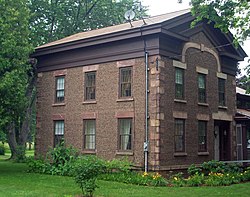Jackson Blood Cobblestone House
|
Jackson Blood Cobblestone House
|
|

South profile and east elevation of main block, 2010
|
|
| Location | Lyndonville, NY |
|---|---|
| Nearest city | Lockport |
| Coordinates | 43°19′0″N 78°23′20″W / 43.31667°N 78.38889°WCoordinates: 43°19′0″N 78°23′20″W / 43.31667°N 78.38889°W |
| Area | 0.8 acres (3,200 m2) |
| Built | 1846 |
| Architectural style | Greek Revival |
| MPS | Cobblestone Architecture of New York State MPS |
| NRHP reference # | 05000635 |
| Added to NRHP | June 30, 2005 |
The Jackson Blood Cobblestone House is located on South Main Street (state highway NY 63) in Lyndonville, New York, United States. It is a Greek Revival house built in the middle of the 19th century.
Blood, a prominent citizen of the surrounding Town of Yates in its early years, built the house with cobblestones he and his family personally transported down to the site from Lake Ontario to the north. Its former chimney arrangement suggests that it was one of the first houses in the area to be heated with stoves instead of fireplaces.
During the first half of the 20th century it was subdivided into three rental units, and much of the interior renovated. Later it was restored to a single-family dwelling. In 2005 it was listed on the National Register of Historic Places. It is the only property in Lyndonville so far listed, and the northernmost entry on the Register in Orleans County.
The house is located on a three-quarter–acre (3,200 m²) lot on the west side of the street south of the village's center, where Route 63 crosses Johnson Creek. The neighborhood is residential, with the houses dating to the late 19th and 20th centuries. Mature trees dominate the lots, giving way to worked fields on either side of the highway. The terrain is level. A modern, non-contributing garage is located at the rear of the lot.
Three sections comprise the house. The main block is a large rectangular three-by-three-bay two and a half stories tall. Two one-and-a-half-story wings extend to the north and west (rear). All are sided in rows of lake-washed medium-sized cobblestones set beads of V-profile lime masonry.
All trim — lintels, sills, quoins and water table — is limestone. That material is also used for an unusual decorative feature on the east (front) facade: a semi-elliptical stone arch with keystone that springs from the lintels of the second story windows. Above it the shallow pitched gabled roof is set off by a very deep plain frieze and molded cornice with returns. The six-over-six double-hung sash windows are original. A mid-20th century porch with square posts is on the east face of the north wing.
...
Wikipedia


